

Behind the News - 08/02/2011: Cyclone. Queensland has been hit with yet another natural disaster, this time a cyclone up north.
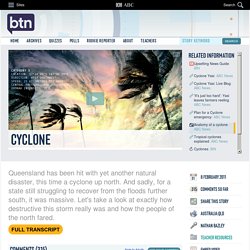
And sadly, for a state still struggling to recover from the floods further south, it was massive. Let's take a look at exactly how destructive this storm really was and how the people of the north fared. ANNA BLIGH, QLD PREMIER: We are facing a very frightening time and many people in far north QLD over the next 24 hours or more will be facing an event that will be terrifying. Yasi was poised to unleash it's fury on a huge area, stretching from Cairns to Townsville and beyond; and it was rated as a category five cyclone, which is the highest category there is. People living there were told to evacuate, as there was a real danger they could be killed. The 285km/hr winds battered all through the night and by morning, locals woke up to find homes completely flattened, roofs ripped from buildings, cars crushed and boats tossed around by the waves. Cyclone_tracy. 1974 Cyclone Tracy.
In 1974 Cyclone Tracy destroyed the City of Darwin in north Australia in a few hours.

See a map of the cyclone path, pictures, photos, sound recordings and salvaged objects in the Darwin Museum exibit. It is hard for anyone who was not there at the time to imagine how it must have felt, however the Museum & Art Gallery of the Northern Territory has a permanent exhibit which is so realistic it's a bit frightening. BOM - Australian Climate Extremes-Cyclone. Cyclone Tracy, Christmas 1974 The year 1974 started with tropical cyclone "Wanda" bringing torrential rain and flooding to Brisbane.

It ended with another major Australian population centre being devastated by a cyclone. If Maitland epitomised flooding in Australia, and Ash Wednesday or Black Friday, bushfires, then "Tracy" comes most readily to Australian minds when cyclones are mentioned. Understanding tropical cyclones. Tropical cyclones threaten northern Australia every year.
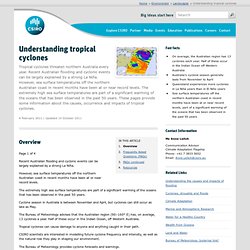
Recent Australian flooding and cyclonic events can be largely explained by a strong La Niña. However, sea surface temperatures off the northern Australian coast in recent months have been at or near record levels. The extremely high sea surface temperatures are part of a significant warming of the oceans that has been observed in the past 50 years. These pages provide some information about the causes, occurrence and impacts of tropical cyclones. 4 February 2011 | Updated 14 October 2011 Overview. Severe Tropical Cyclone Yasi. 30 January - 3 February 2011 Summary Severe Tropical Cyclone Yasi began developing as a tropical low northwest of Fiji on 29th January and started tracking on a general westward track.

The system quickly intensified to a cyclone category to the north of Vanuatu and was named Yasi at 10pm on the 30th by Fiji Meteorological Service. Previous Tropical Cyclones. The Australian Tropical Cyclone Database Details of all tropical cyclones that are known to have occurred are contained in a database maintained by the Bureau of Meteorology.

Cyclone. Hazards Skip to Navigation | Skip to Content.
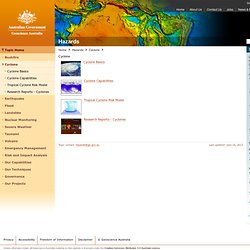
Sky Diary KIDSTORM * facts about hurricanes. Hurricanes are mind-boggling in their size and strength.

Modern technology lets us see how big hurricanes are and track them through satellite imagery, while storm-penetrating aircraft measure their strength, in terms of wind speeds and atmospheric pressure. That technology gives us detailed warnings that people a century ago never had. Hurricanes usually form in the tropical zones north and south of the equator, where warm waters offer ample fuel for storm formation. That's where you see convection, where warm air rises and forms clusters of thunderstorms. Anatomy of Katrina. Weather Wiz Kids weather information for kids. Who are the "Hurricane Hunters"?
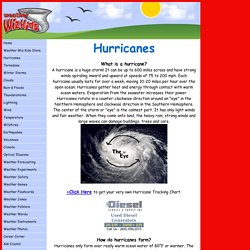
The brave "hurricane hunters" work for the National Oceanic and Atmospheric Administration (NOAA). Each mission lasts about ten hours, with the crews passing four to six times through the storm. Hurricanes. How Hurricanes Work" As hurricane Sandy made its way to the Eastern coast of the United States in October 2012, meteorologists called the storm unprecedented in terms of its potential for damage and fatalities.
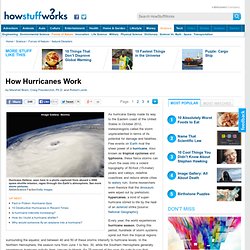
Few events on Earth rival the sheer power of a hurricane. Also known as tropical cyclones and typhoons, these fierce storms can churn the seas into a violent topography of 50-foot (15-meter) peaks and valleys, redefine coastlines and reduce whole cities to watery ruin. Some researchers even theorize that the dinosaurs were wiped out by prehistoric hypercanes, a kind of super-hurricane stirred to life by the heat of an asteroid strike [source: National Geographic]. Every year, the world experiences hurricane season. Education Resources: Hurricanes Collection. 1. Cataclysmic cyclones. Sandy strikes Eastern Seaboard Hurricane Sandy, sometimes called “Superstorm Sandy,” cruised up the East Coast in October, then made a sharp left to cross the New Jersey coast on Oct. 29, causing wind damage, flooding and deaths across the Northeast. October 29, 2012: A section of US 158 in North Carolina, as Hurricane Sandy makes landfall.
The enormous storm was born in the Western Caribbean on Oct. 22, and at one point was 1,100 miles across, a record for an Atlantic hurricane. Fed by two other weather systems, it created a storm surge and flooding across New York City’s low-lying areas, including parts of Queens and Manhattan. Millions lost electric power, transit systems were shut down, subways and tunnels flooded.